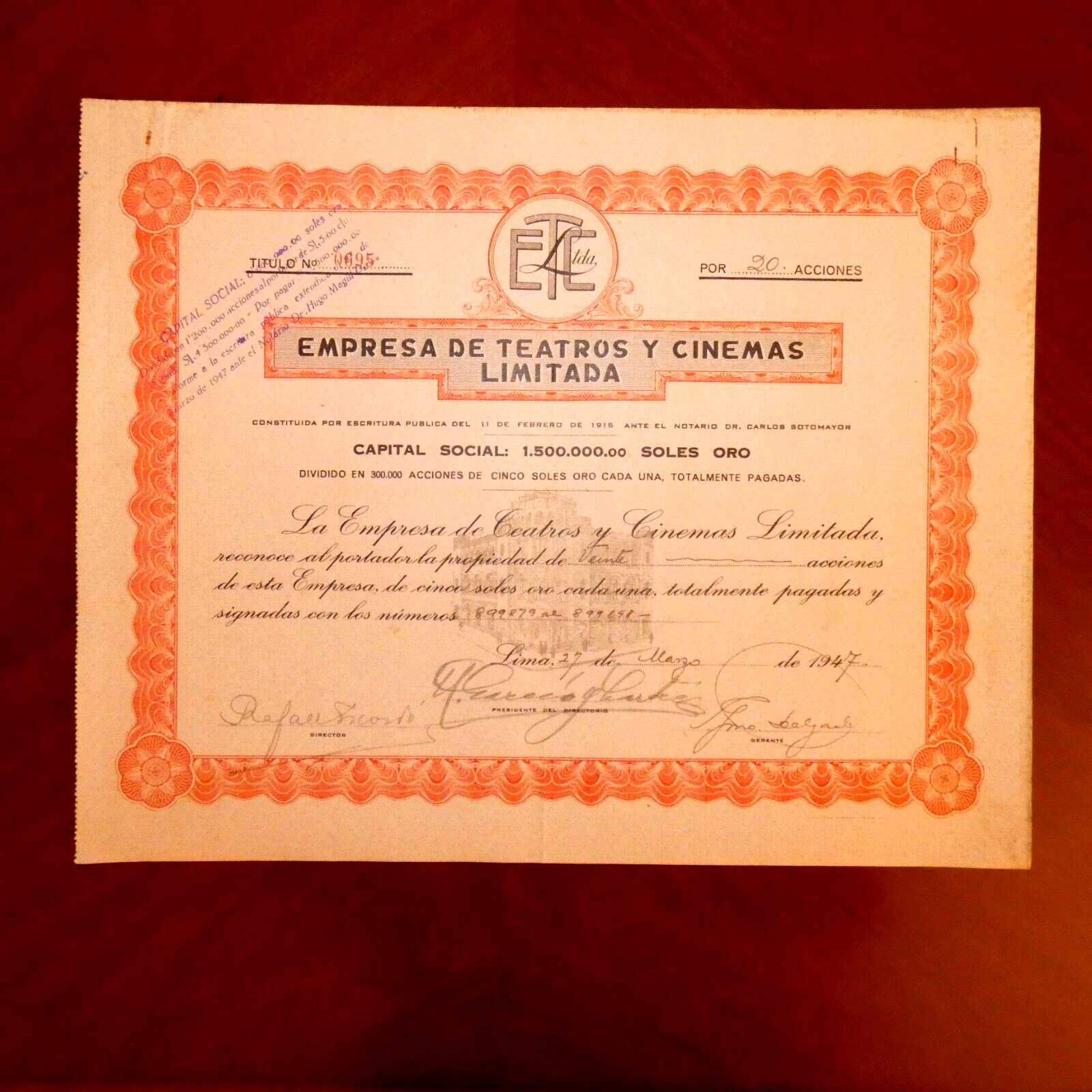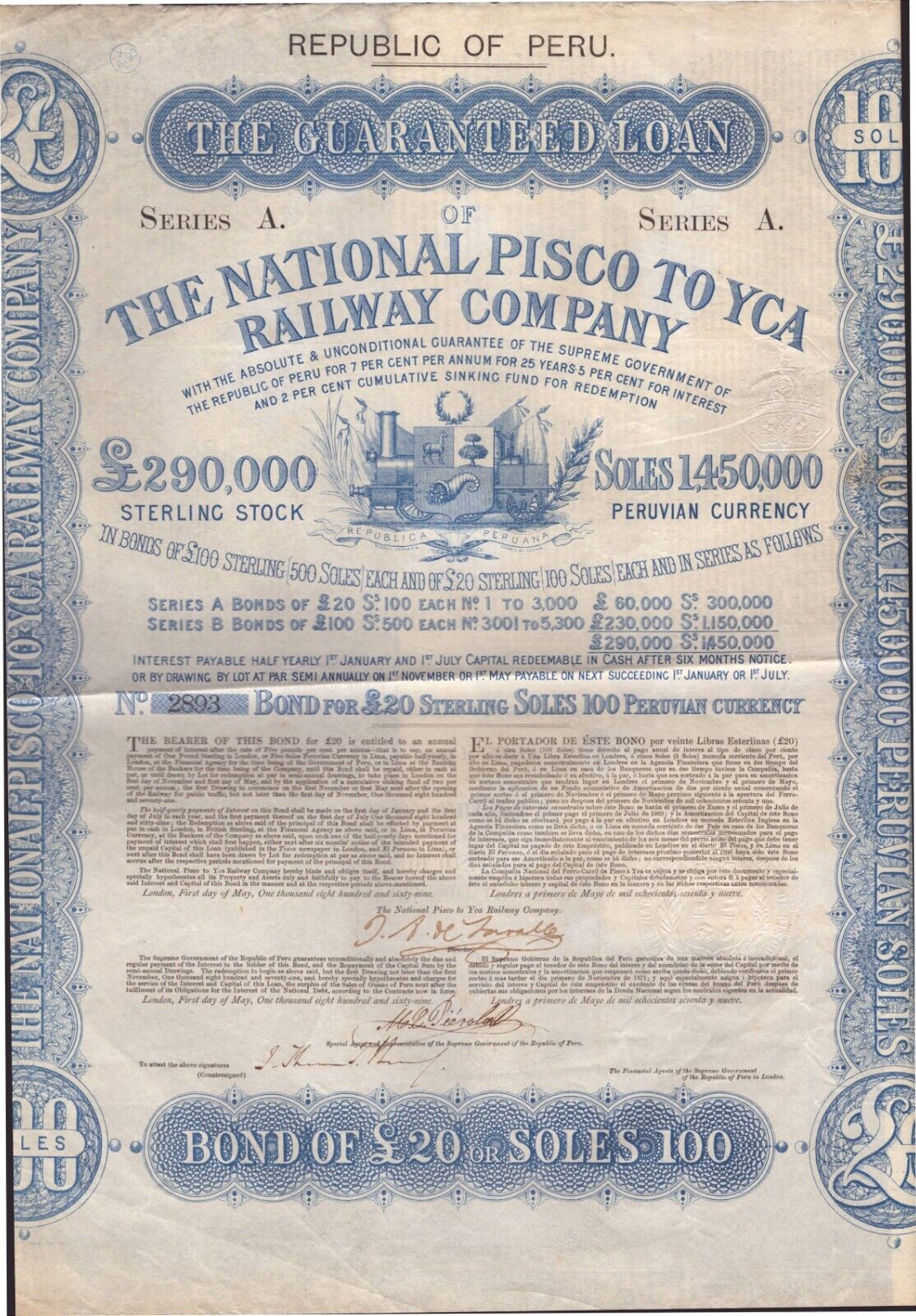-40%
Empresa de Teatros y Cinemas Limitada ,Lima ,Peru 1947 certificado de acciones
$ 24.81
- Description
- Size Guide
Description
One bearer share certificate ( for 20 shares single document) of"
Empresa de Teatros y Cinemas Limitada" ,Lima ,Peru 1947
certificado de acciones. Condition (opinion):Very Good+/Fine (VG+/F) ,see scan.Three handwritten signatures.Watermark paper, dry seals . Size:23,7cm/30cm." Uncancelled .See below for related information from the web.
Historical document for collectable or
historical research only.
Use this picture for reference only, serial number may be different.
Please read carefully the sale terms ,shipping conditions and information below. The buyer accepts those terms, conditions and cost described.
----------------------------------------------------------------------------------------
Terms of sale and shippig information
Postage, including packing material, handling fees : Europe: USD 9.00 / USA $ 9.99. Rest of the World: USD 11.15.
FREE of postage for other items.
(excluding
purchases under US.00 with a weight greater than 100 gr. including the protection and packaging card ) .
Only one shipping charge per shipment (the highest one) no matter how many items you buy (combined shipping).
-----------------------------------------------------------------------------
Guaranteed genuine -
One
month
return
policy
(retail sales) .
Returns accepted with no questions.
Customers are invited to combine purchases to save postage.
As we have (or could have) more than one identical item ,the serial number may differ from those shown in the picture which is for reference only.
For purchases above .00 we send the orders registered with tracking number without extra charge, for purchases below .00 we ship as regular letters at the buyer's risk.
For purchases below $ 70,00 who want to register your letter with tracking number, please add an extra for : Europe .20 , U.S. .00 ,Rest of the word .90 .For this case ,please request or wait for our invoice before paying.
Postage include packaging material and handling fees.
For some destinations and purchases below .00 customers may be requested for this extra shipping payment in order to register the shipment with tracking number.
We reserve the right to cancel transactions that require the sending of unregistered letters (without tracking number) to some destinations when this extra payment has been requested.
For purchases over .00, the excess weight will be free.
For purchases under US.00 with a weight greater than 100 gr. including the protection and packaging card, the buyer is asked not to make the payment until receiving the invoice or shipment note, since the cost will be calculated and the type of shipment will be assessed (registered or insured or not) and the buyer will be charged the approximate total of the costs of the Post Office rate (rates that are public and can be consulted), in this case the costs of packaging materials, handling and delivery management are free.
In the event that the buyer has already made the payment, he will be asked to pay the difference that is missing for the payment of the postal rate. Likewise, we reserve the right to cancel transactions that have not been paid this extra amount when requested.
If for any reason, your item did not arrive yet, or you are not 100% satisfied with the item you have received, please do not hesitate to contact , I will do all it takes to provide the best service.
Full refund policy ,including shipping cost, guaranteed in case of lost or theft after the completion of the complaint with Spanish Correos for the registered letters
(free of extra charges for purchases abobe .00 or with the extra charge paid for purchases below .00).
The buyer must notify to us of the delay in the arrival of his purchase when he meets 3 weeks ( to Europe) to 4 weeks (rest of the World) this guarantee expires two months after the shipment of his purchase if we have not previously received notice of the delay
.
----------------------------------------------------------------------------------------
Banknote Grading
UNC
AU
EF
VF
F
VG
G
Fair
Poor
Uncirculated
About Uncirculated
Extremely Fine
Very Fine
Fine
Very Good
Good
Fair
Poor
Edges
no counting marks
light counting folds OR...
light counting folds
corners are not fully rounded
much handling on edges
rounded edges
Folds
no folds
...OR one light fold through center
max. three light folds or one strong crease
several horizontal and vertical folds
many folds and creases
Paper
color
paper is clean with bright colors
paper may have minimal dirt or some color smudging, but still crisp
paper is not excessively dirty, but may have some softness
paper may be dirty, discolored or stained
very dirty, discolored and with some writing
very dirty, discolorated, with writing and some obscured portions
very dirty, discolored, with writing and obscured portions
Tears
no tears
no tears into the border
minor tears in the border, but out of design
tears into the design
Holes
no holes
no center hole, but staple hole usual
center hole and staple hole
Integrity
no pieces missing
no large pieces missing
piece missing
piece missing or tape holding pieces together
----------------------------------------------------------------------------------------------------------------------------------------------------------------------------
See below related information from the web:
The Teatro Colón was one of the main theaters in the city of Lima.1 2 It is located in the historic center of the city of Lima, capital of Peru. The theater belonged to
Teatros y Cinemas Ltda
. Its construction began in 1911, being inaugurated on January 18, 1914.1 3 The theater fell into disuse at the beginning of 2000.
History
Before the theater, it is known that the land belonged to a man named José Manuel Alejo de Hurtado, in the mid-19th century. The property would have different owners until it was acquired by the company Teatros y Cinemas Ltda., in the year 1911. Thus, the construction of the theater began at the hands of the architect of French origin, Claude Sahut (designer and builder of various works in Lima throughout the 1910s and 1920s).
After the work was completed in 1914, the Teatro Colón was inaugurated with the play «Los Fantoches», staged by the "Fabregas" Theater Company. This is how the theater offers, throughout its early years, different shows and performances by small theater companies, both national and foreign. However, it is from 1921 that he begins with the projection of films, little by little leaving aside his theatrical aspect to, finally in 1927, dedicating himself exclusively to film reproduction.4
In 1936, the theater began a remodeling process: Inside, the independent boxes located on the first floor surrounding the stalls and the high boxes located above them on the second level were eliminated; the dome is eradicated and one more floor is added to the structure. All this in order to adapt it to its new role as a movie theater and to show a more harmonious appearance with the rest of the surrounding structures.
In 1972, the Revolutionary Government of the Armed Forces of General Juan Velasco Alvarado commissioned the expropriation of the site. 4 Later, it was declared a National Monument, with which it became part of the Nation's Immovable Cultural Heritage.
In the 1980s and 1990s, the Teatro Colón became a space dedicated to the projection of films for adults, as well as other private cinema and theater spaces in Lima, due to both the economic crisis and the decline of the cultural spaces themselves.
Finally, in the year 2000 the authorities decided to close the space alleging that "it affected the decoration of the city and the maintenance of good customs". However, the measure was disobeyed by the owners, so the Municipality of Lima boarded up the doors and facilities.
In 2004, the Teatro Colón was auctioned by the metropolitan commune and acquired by the Theater Directorate of the Ministry of Culture.5
In March 2005, the NGO "Proyecto Cultural Colón Theater" was established, which aims to rehabilitate the totally deteriorated structure of the Theater in order to turn it into a cultural space again.
----------------------------------------------------------------------------------------------------------------------------------------------------------------------------
El Teatro Colón era uno de los principales teatros de la ciudad de Lima.12 Se ubica en pleno centro histórico de la ciudad de Lima, capital del Perú. El teatro pertenecía a
Teatros y Cinemas Ltda
. Se inició su construcción en 1911, siendo el 18 de enero de 1914 inaugurado.13 El teatro cayó en desuso a inicios del 2000.
Historia
Anterior al teatro, se tiene conocimiento que el terreno perteneció a un hombre llamado José Manuel Alejo de Hurtado, a mediados del siglo XIX. El predio tendría diversos dueños hasta que fue adquirido por la empresa Teatros y Cinemas Ltda., en el año de 1911. Es así que, se inicia con la construcción del teatro a manos del arquitecto de origen francés, Claude Sahut (diseñador y constructor de diversas obras en Lima a lo largo de la década de 1910 y 1920).
Concluido el trabajo en 1914, el Teatro Colón es inaugurado con la obra «Los Fantoches», puesta en escena de la Compañía de Teatro "Fabregas". Es así como el teatro ofrece, a lo largo de sus primeros años, distintos espectáculos y actuaciones de pequeñas compañías teatrales tanto nacionales como extranjeras. Sin embargo, es a partir de 1921 que inicia con la proyección de películas, dejando poco a poco de lado su aspecto teatral para, finalmente en el año 1927, dedicarse exclusivamente a la reproducción cinematográfica.4
En 1936, el teatro inicia con un proceso de remodelación: Al interior, se eliminan los palcos independientes ubicados en la primera planta circundando la platea y los palcos altos ubicados sobre ellos en el segundo nivel; se erradica la cúpula y se le añade un piso más a la estructura. Todo ello con la finalidad de adecuarlo a su nuevo rol como sala de cine y de mostrar un aspecto más armónico con el resto de estructuras circundantes.
En 1972, el Gobierno Revolucionario de la Fuerza Armada del general Juan Velasco Alvarado encargó la expropiación del recinto.4 Posteriormente, lo declaró Monumento Nacional, con lo que pasó a formar parte del Patrimonio Cultural Inmueble de la Nación.
Para los años 1980 y 1990, el Teatro Colón se convierte en un espacio dedicado a la proyección del cine para adultos, así como otros de los espacios particulares de cine y teatro en Lima, ello debido tanto a la crisis económica como a la decadencia de los espacios culturales en sí.
Finalmente, en el año 2000 las autoridades decidieron clausurar el espacio alegando que "afectaba el ornato de la ciudad y el mantenimiento de las buenas costumbres". Sin embargo, la medida fue desacatada por los propietarios, por lo que la Municipalidad de Lima tapió las puertas e instalaciones.
En el año 2004, el Teatro Colón fue subastado por la comuna metropolitana y adquirido por la Dirección de Teatro del Ministerio de Cultura.5
En marzo de 2005 se constituye la ONG "Proyecto Cultural Teatro Colón", la cual tiene como objetivo rehabilitar la estructura totalmente deteriorada del Teatro para poder convertirlo nuevamente en un espacio cultural.
Your browser does not support JavaScript. To view this page, enable JavaScript if it is disable












